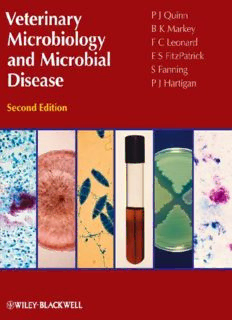Table Of ContentContents
Preface
Acknowledgements
Author biographies
Section I Introduction to Microbiology
Infection Immunity and Molecular Diagnostic
Methods
1 Microbiology microbial pathogens and infectious
disease
Further reading
2 Subdivisions classification and morphological
characterization of infectious agents
Microscopical techniques
Pathogenic microorganisms
Biological classification and nomenclature
References
Further reading
3 Infection and immunity
Normal flora
Comparative aspects of innate and adaptive immunity
Recognition of pathogens
Cells involved in innate immune responses
Complement
Adaptive immunity
Immunity to bacteria
Immunity to fungi
Immunity to viruses
Concluding comments
References
Further reading
4 Immunodeficiency diseases
Severe combined immunodeficiency diseases
Thymic aplasia or hypoplasia
Wiskott-Aldrich syndrome
Primary immunodeficiency diseases involving B lymphocytes
Secondary immunodeficiency
Further reading
5 Vaccines and vaccination
Vaccination
Inactivated vaccines
Live attenuated vaccines
Vaccines produced by recombinant nucleic acid technology
Synthetic peptide vaccines
DNA vaccines
Reverse vaccinology
Adjuvants
Administration of vaccines
Adverse reactions following vaccination
Vaccination failure
References
Further reading
6 Molecular diagnostic methods
Analytical properties of nucleic acid
Molecular hybridization
DNA sequencing
Polymerase chain reaction (PCR)
Real-time PCR
Diagnostic approaches to surveillance and subtyping of
bacteria a comparison of phenotyping and genotyping methods
Molecular subtyping for definitive identification of bacteria
Plasmid profiling
Restriction endonuclease analysis (REA)
Ribotyping
Pulsed-field gel electrophoresis (PFGE)
PCR-based subtyping methods
Multilocus sequence typing (MLST)
DNA microarray technology
Whole bacterial genome sequencing
References
Further reading
Section II Introductory Bacteriology
7 The structure of bacterial cells
Capsule
Cell wall
Cytoplasmic membrane
Cytoplasm
Ribosomes
Nuclear material
Flagella
Pili
Biofilms
Protein secretion systems
Endospores
Reference
Further reading
8 Cultivation preservation and inactivation of bacteria
Bacterial growth
Bacterial nutrition
Physical and chemical factors which influence growth
Preservation of microorganisms
Physical methods for inactivating microorganisms
Biosafety cabinets
Reference
Further reading
9 Bacterial genetics mechanisms of genetic variation
and gene databases
Replication of bacterial DNA
Transcription and translation the expression of genetic
information
Mechanisms contributing to genetic variation
Examples of mobile genetic elements
Genetic engineering of bacteria in the laboratory
Genetic databases and bioinformatics
Further reading
10 Laboratory diagnosis of bacterial disease
Selection collection and transportation of specimens
Identification of pathogenic bacteria
Serology
Further reading
11 Antibacterial agents
Development of chemotherapy for bacterial infections
Mode and site of action
Combined antibacterial therapy
Factors influencing a ntibacterial activity
Further reading
12 Antibacterial resistance
Resistance mechanisms
Multiple drug resistance
Strategies for limiting a ntibacterial resistance
Antibacterial susceptibility testing
References
Further reading
13 Bacterial colonization tissue invasion and clinical
disease
Commensals
Pathogens
Colonization and growth
Pathogen-host interactions
Virulence factors
Responses of the host to bacterial pathogens
The clinical spectrum of bacterial disease
References
Section III Pathogenic Bacteria
14 Staphylococcus species
Usual habitat
Differentiation of Staphylococcus species
Pathogenesis and pathogenicity
Diagnostic procedures
Clinical infections
References
Further reading
15 Streptococci
Usual habitat
Differentiation of the streptococci
Pathogenesis and pathogenicity
Diagnostic procedures
Clinical infections
References
Further reading
16 Actinobacteria
Actinomyces Arcanobacterium and Actinobaculum species
Nocardia species
Dermatophilus congolensis
Crossiella equi
References
Further reading
17 Corynebacterium species
Usual habitat
Differentiation of the corynebacteria
Pathogenesis and pathogenicity
Diagnostic procedures
Clinical infections
References
Further reading
18 Rhodococcus equi
Usual habitat
Clinical infections
References
Further reading
19 Listeria species
Usual habitat
Differentiation of Listeria species
Pathogenesis and pathogenicity
Clinical infections
References
Further reading
20 Erysipelothrix rhusiopathiae
Usual habitat
Definitive identification of Erysipelothrix rhusiopathiae
Pathogenesis and pathogenicity
Clinical infections
References
Further reading
21 Bacillus species
Usual habitat
Differentiation of Bacillus species
Clinical infections
Infections with Bacillus licheniformis
References
Further reading
22 Clostridium species
Usual habitat
Specimen collection and cultural requirements
Detection and differentiation of clostridia
Clinical conditions caused by neurotoxic clostridia
Clinical conditions caused by histotoxic clostridia
Enteropathogenic and enterotoxaemia-producing clostridia
References
Further reading
23 Mycobacterium species
Usual habitat
Differentiation of pathogenic mycobacteria
Clinical infections
References
Further reading
24 Enterobacteriaceae
Usual habitat
Differentiation of the Enterobacteriaceae
Escherichia coli
Salmonella serotypes
Yersinia species
Opportunistic pathogens
References
Further reading
25 Pseudomonas aeruginosa and Burkholderia species
Usual habitat
Differentiation of Pseudomonas and Burkholderia species
Clinical infections
References
Further reading
26 Actinobacillus species
Usual habitat
Differentiation of Actinobacillus species
Pathogenesis and pathogenicity
Clinical infections
References
Further reading
27 Pasteurella species Mannheimia haemolytica and
Bibersteinia trehalosi
Usual habitat
Differentiation of Pasteurella Bibersteinia and Mannheimia
species
Pathogenesis and pathogenicity
Diagnostic procedures
Clinical infections
References
Further reading
Description:Microbiology is one of the core subjects for veterinary students, and since its first publication in 2002, Veterinary Microbiology and Microbial Disease has become an essential text for students of veterinary medicine. Fully revised and expanded, this new edition updates the subject for pre-clinical

